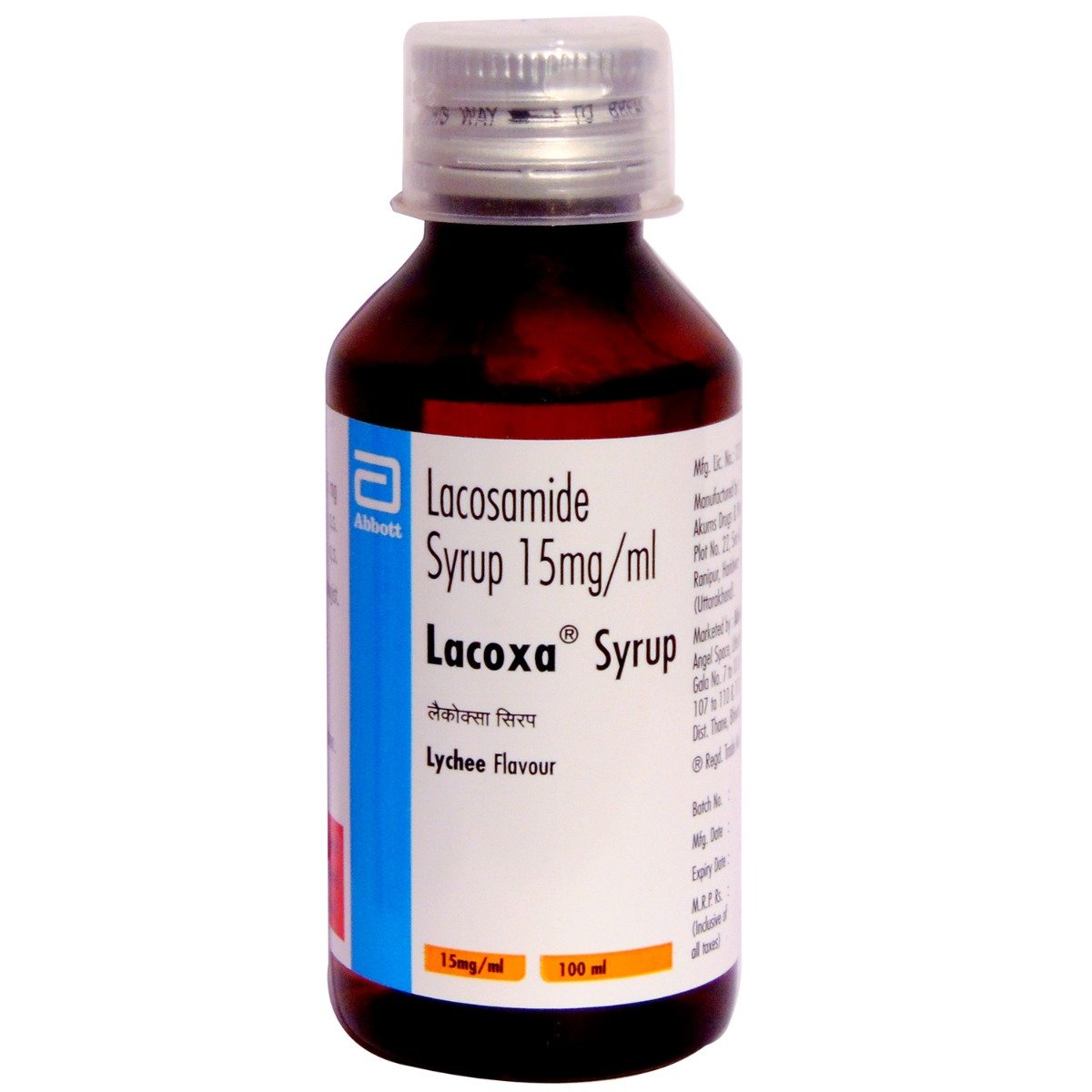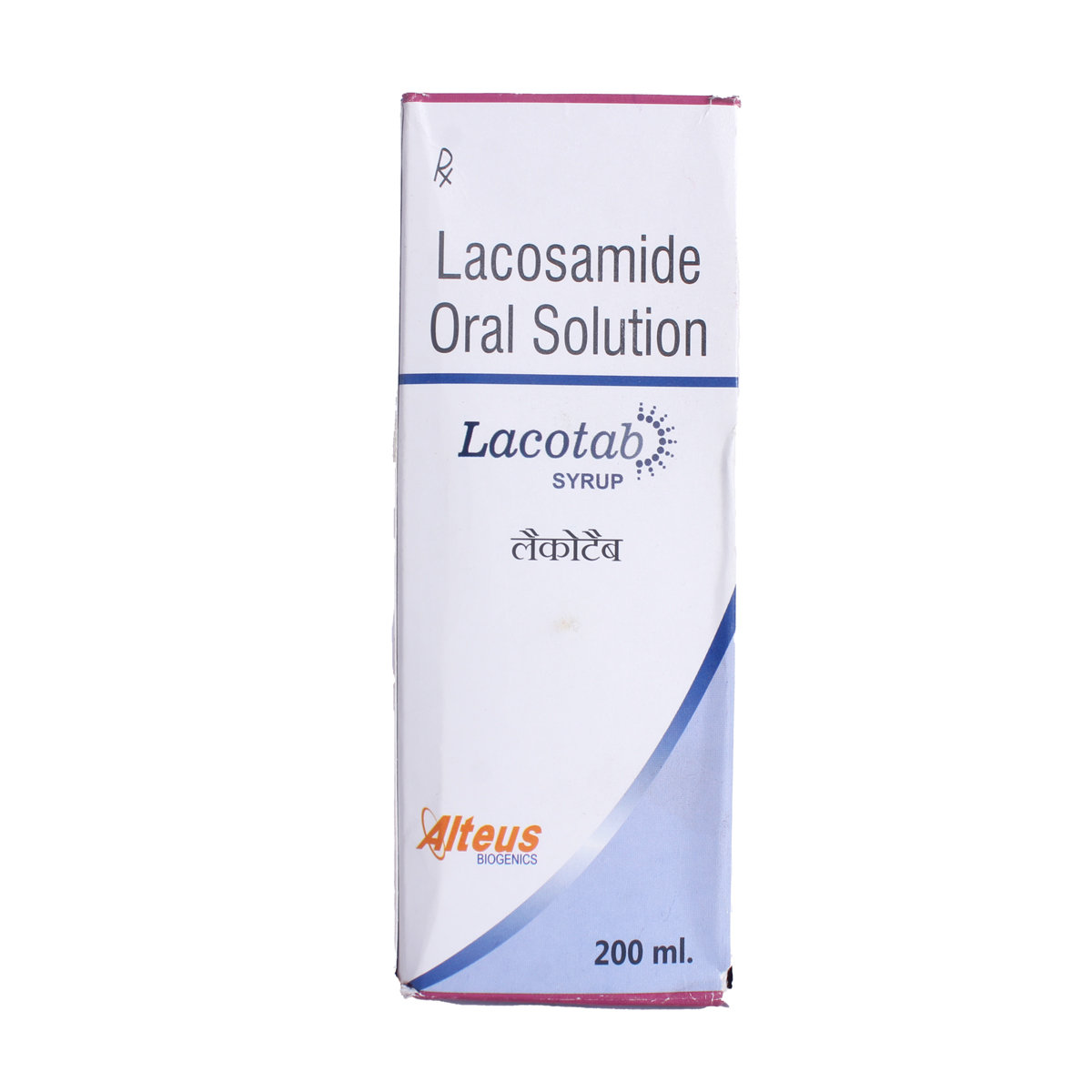Lacosam Syrup 200 ml




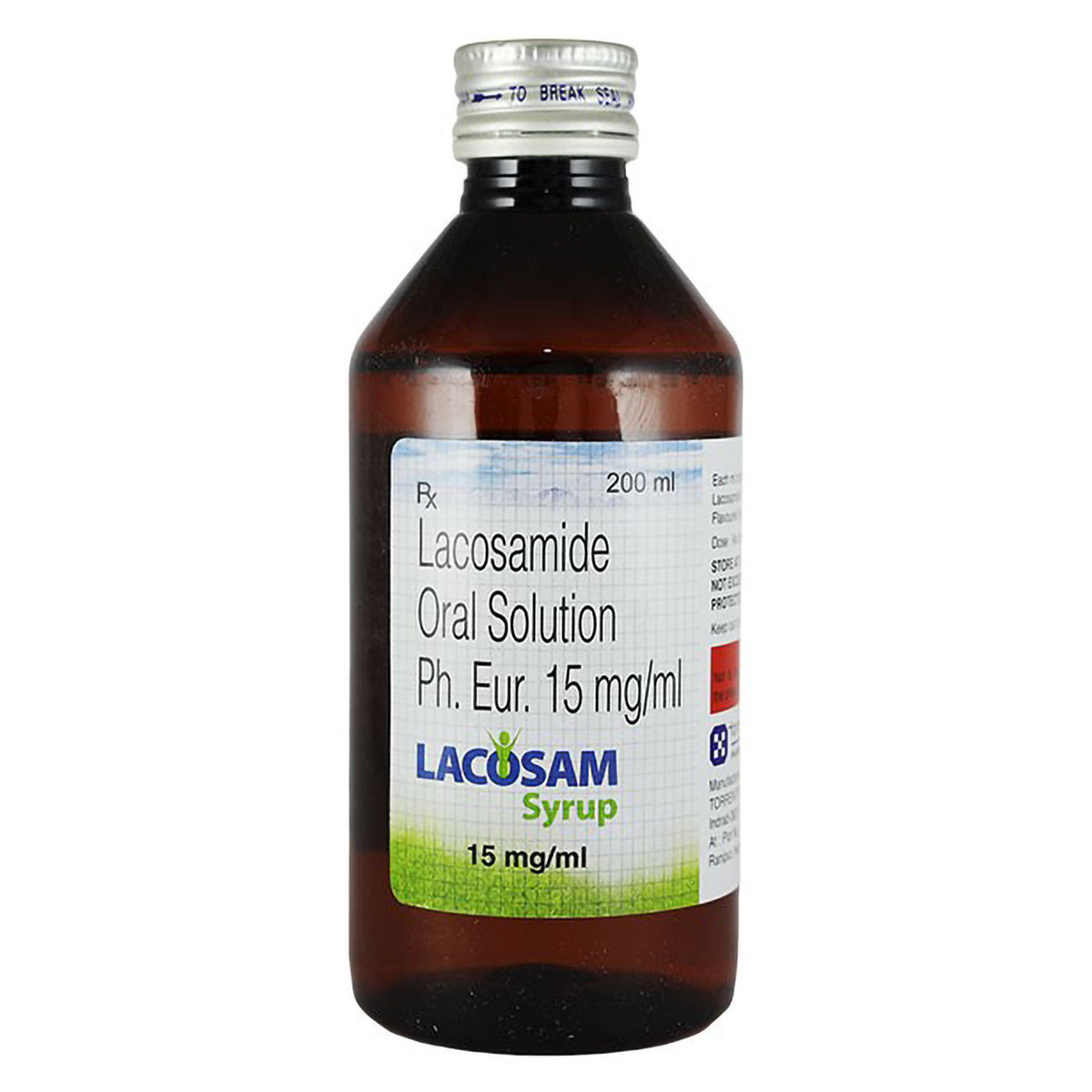
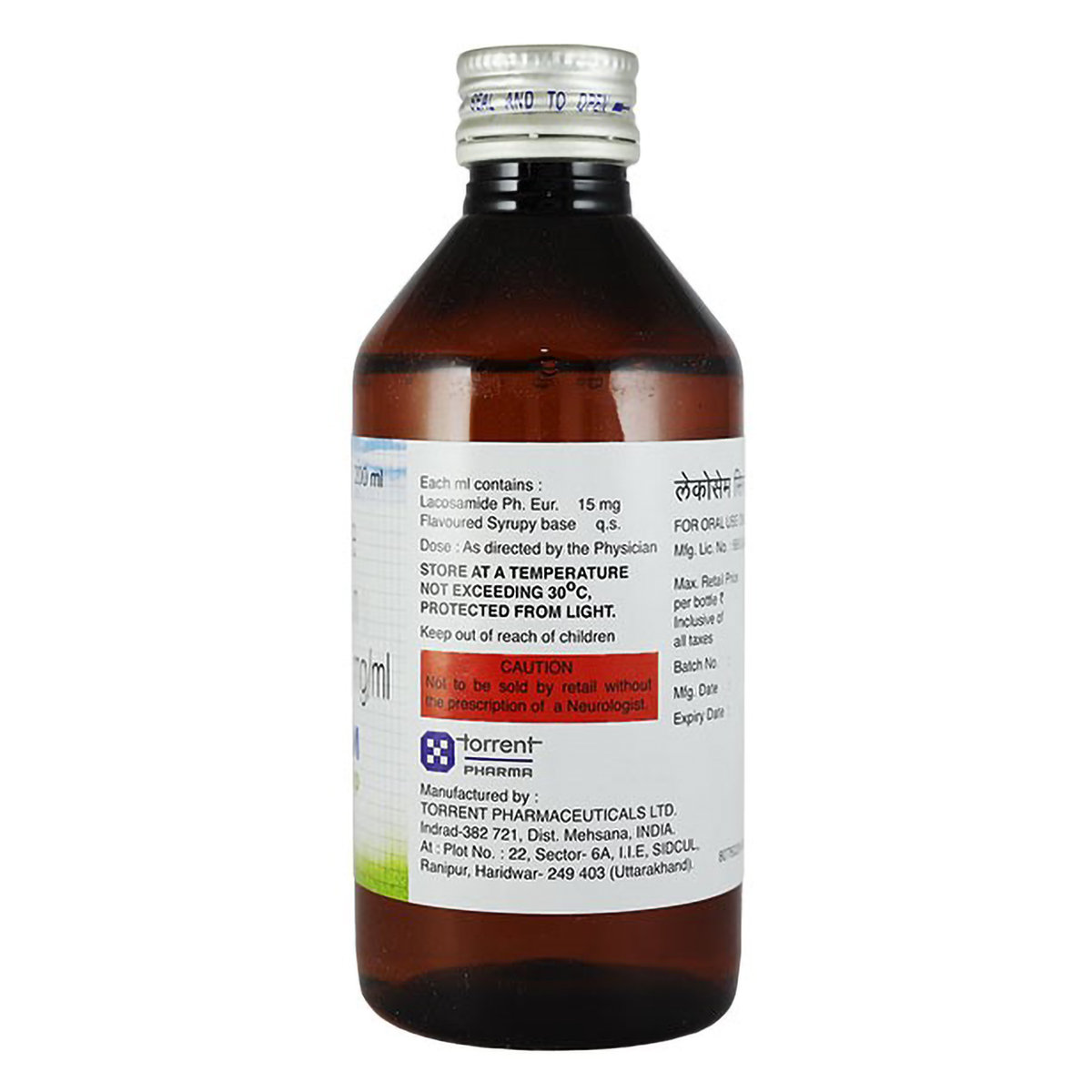
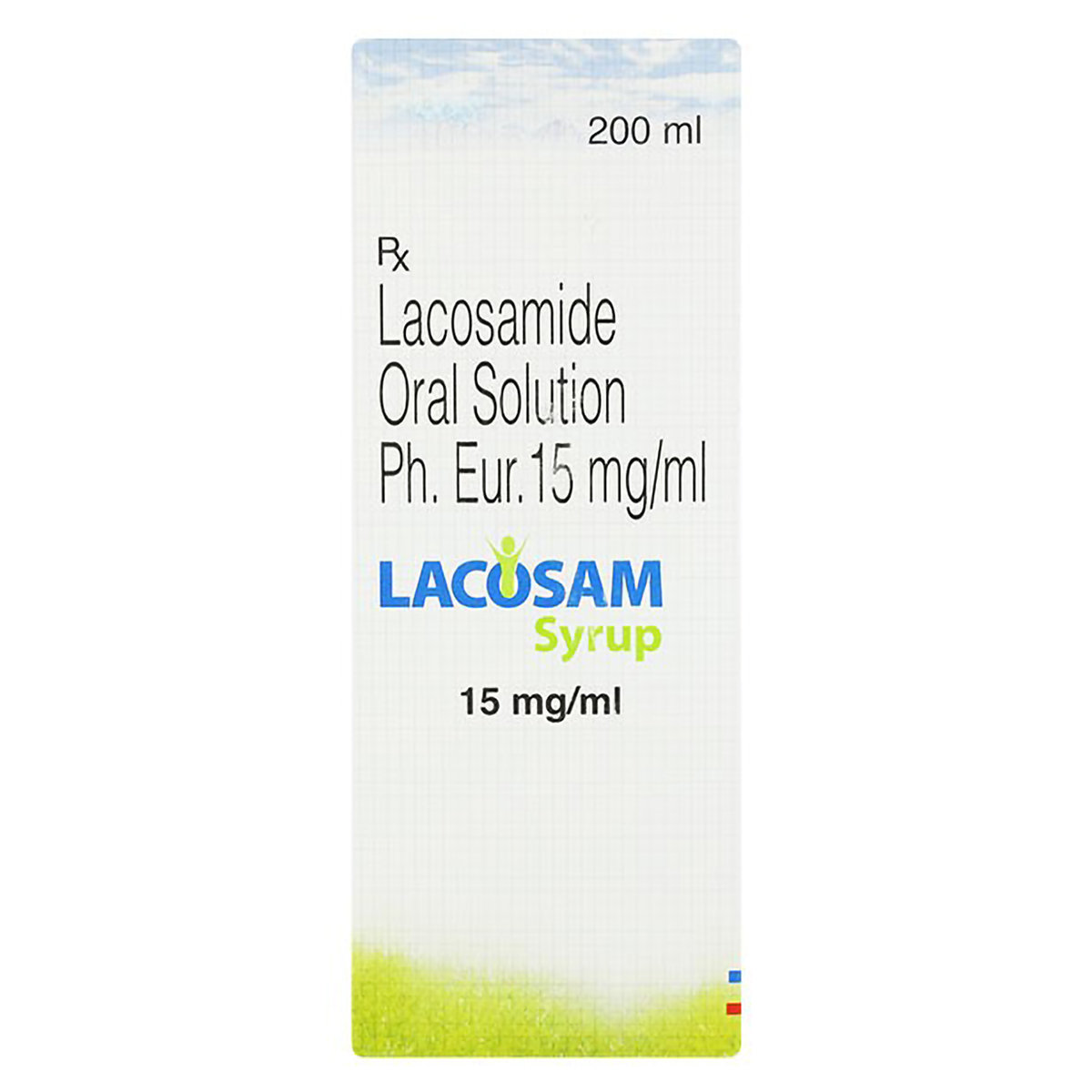
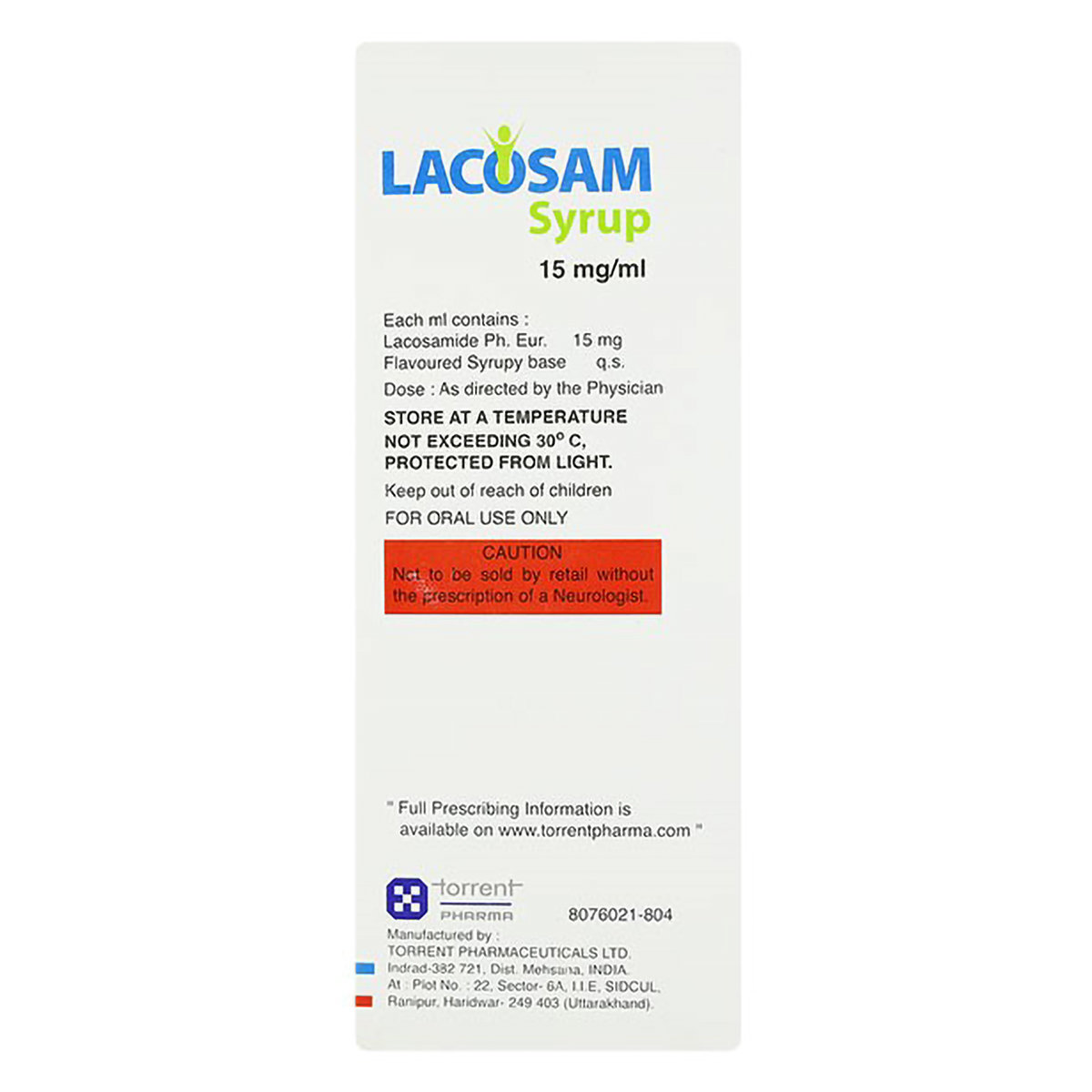
MRP ₹640.5
(Inclusive of all Taxes)
₹96.1 Cashback (15%)
Provide Delivery Location
Online payment accepted
 Prescription drug
Prescription drugWhats That
Composition :
Manufacturer/Marketer :
Consume Type :
Return Policy :
Expires on or after :
About Lacosam Syrup
Lacosam Syrup belongs to the class of anticonvulsants, which is primarily used to treat focal (partial) seizures in adults and children four years of age or older. Focal or partial-onset seizures are characterized by abnormal electrical activity in only one brain hemisphere.
Lacosam Syrup contains lacosamide, which treats seizures by decreasing disorganized electrical activity in the brain.
It is given as monotherapy or in combination with other antiepileptic drugs. Lacosam Syrup should be taken in the dose and duration your doctor advises. In some cases, you may experience certain common side effects of Lacosam Syrup : nausea, vomiting, diarrhoea, headache, confusion, dizziness, uncontrolled movements of the eye, blurred vision, double vision (diplopia), mood disturbances, itching, tremors, fatigue, and trouble walking. Consult your doctor if the side effects persist or worsen over time. Some people may also experience suicidal thoughts. Seek medical attention immediately in such cases.
Don’t stop taking Lacosam Syrup even if your condition is controlled, as abrupt stopping may cause the recurrence of the seizures. Before taking Lacosam Syrup , inform your doctor if you are allergic to lacosamide or other ingredients. Inform your doctor if using other antiepileptics, prescription or non-prescription drugs, nutritional supplements, or herbal products. Inform your doctor if you are diagnosed with depression, severe renal impairment, arrhythmias (atrioventricular block, atrial fibrillation, and atrial flutter), severe heart failure, or a heart attack.
Uses of Lacosam Syrup
Directions for Use
Medicinal Benefits
Lacosam Syrup is an antiepileptic drug, also called anticonvulsants. It treats focal seizures in adults and children above four years of age. Seizures occur due to abnormal electrical activity in the brain. Lacosam Syrup can inactivate the sodium channels across the neuron membranes. This inactivation decreases neuron signals, thereby decreasing the electrical disturbance or abnormal activity in the brain.
- Wear an eye patch or opaque contact lens or lens applied to glasses to block the vision of one eye to minimize double vision.
- Use prisms (lenses applied to glasses) to correct double vision due to small misalignments.
- Try doing some eye exercises such as moving the target towards nose slowly or focussing on a detailed target like thin stick or small text in a magazine.
- If you feel eye pain, develop bulging eyes, have weakness, headache or double vision, consult a doctor immediately.
- Hydrate your body: Drink enough water to prevent dehydration and headaches.
- Calm Your Mind: Deep breathing and meditation can help you relax and relieve stress.
- Rest and Recharge: Sleep for 7-8 hours to reduce headache triggers.
- Take rest: lie down in a quiet, dark environment.
- Cold or warm compresses can help reduce tension.
- Stay Upright: Maintain good posture to keep symptoms from getting worse.
- To treat headaches naturally, try acupuncture or massage therapy.
- Over-the-counter pain relievers include acetaminophen and ibuprofen.
- Prescription Assistance: Speak with your doctor about more substantial drug alternatives.
- Severe Headaches: Seek emergency medical assistance for sudden, severe headaches.
- Frequent Headaches: If you get reoccurring headaches, consult your doctor.
- Headaches with Symptoms: Seek medical attention if your headaches include fever, disorientation, or weakness.
- Inform your doctor about dizziness symptoms. They may adjust your medication regimen or prescribe additional medications to manage symptoms.
- Follow your doctor's instructions for taking medication, and take it at the same time every day to minimize dizziness.
- When standing up, do so slowly and carefully to avoid sudden dizziness.
- Avoid making sudden movements, such as turning or bending quickly, which can exacerbate dizziness.
- Drink plenty of water throughout the day to stay hydrated and help alleviate dizziness symptoms.
- If you're feeling dizzy, sit or lie down and rest until the dizziness passes.
- Track when dizziness occurs and any factors that may trigger it, and share this information with your doctor to help manage symptoms.
- Inform your doctor about the nausea and discuss possible alternatives to the medication or adjustments to the dosage.
- Divide your daily food intake into smaller, more frequent meals to reduce nausea.
- Opt for bland, easily digestible foods like crackers, toast, plain rice, bananas, and applesauce.
- Avoid certain foods that can trigger nausea, such as fatty, greasy, spicy, and smelly foods.
- Drink plenty of fluids, such as water, clear broth, or electrolyte-rich beverages like coconut water or sports drinks.
- Use ginger (tea, ale, or candies) to help relieve nausea.
- Get adequate rest and also avoid strenuous activities that can worsen nausea.
- Talk to your doctor about taking anti-nausea medication if your nausea is severe.
- Record when your nausea occurs, what triggers it, and what provides relief to help you identify patterns and manage your symptoms more effectively.
- Uncoordinated muscle movements need immediate medical attention.
- Observe your movements and try to understand and control the particular movement.
- Regularly do strengthening exercises to improve blood flow throughout the body and avoid involuntary movements.
- Implement massage techniques to enhance blood flow to organs.
- Take a balanced diet and quit smoking.
- Practice yoga and meditation to improve thought processes and reduce uncontrolled and involuntary movements.
- Preventing Vomiting (Before it Happens)
- Take medication exactly as prescribed by your doctor. This can help minimize side effects, including vomiting.
- Having a small meal before taking your medication can help reduce nausea and vomiting.
- Talk to your doctor about taking anti-nausea medication along with your prescribed medication.
- Managing Vomiting (If it Happens)
- Try taking ginger in the form of tea, ale, or candy to help alleviate nausea and vomiting.
- What to Do if Vomiting Persists
- Consult your doctor if vomiting continues or worsens, consult the doctor for guidance on adjusting your medication or additional treatment.
- Chest pain may last for a while and needs immediate medical attention as it is a significant health issue to be attended to.
- Take rest and refrain from doing physical activity for a while, and restart after a few days.
- Try applying an ice pack to the strained area for at least 20 minutes thrice a day. Ice pack thus helps reduce inflammation.
- Sit upright and maintain proper posture if there is persistent chest pain. Use extra pillows to elevate your position and prop your chest up while sleeping.
Drug Warnings
Inform your doctor if you use other antiepileptics, prescription or non-prescription drugs, nutritional supplements, or herbal products. Do not take Lacosam Syrup if you are allergic to any of its contents. Inform your doctor before taking Lacosam Syrup if you have or had heart problems, kidney and liver problems, if you have low levels of sodium in blood or if you are taking medicines that could lower the sodium levels in the blood, or if you are using hormonal contraceptives. Do not stop taking Lacosam Syrup without consulting your doctor to avoid precipitating seizures. Avoid intake of Lacosam Syrup if you are pregnant or planning for pregnancy unless prescribed by the doctor. Nursing mothers should consult the doctor before using the Lacosam Syrup as it may pass into the breast milk and affect the baby. Lacosam Syrup causes drowsiness and dizziness, so drive only if you are alert. Lacosam Syrup should not be given to children unless prescribed. Avoid consuming alcohol with Lacosam Syrup as it could lead to increased dizziness and sleepiness. Consult your doctor immediately if you experience suicidal tendencies.
Drug-Drug Interactions
Drug-Drug Interactions
Login/Sign Up
Co-administration of Lacosam Syrup 200 ml along with Saquinavir can raise the chance of an abnormal heart rhythm.
How to manage the interaction:
Although taking Lacosam Syrup 200 ml and Saquinavir together can result in an interaction, it can be taken if a doctor has prescribed it. However, if you experience sudden lightheadedness, fainting, a slow heartbeat, or dizziness, consult a doctor. Do not discontinue any medications without a doctor's advice.
Taking Ceritinib together with Lacosam Syrup 200 ml can slow your heart rate and increase the risk of an irregular heart rhythm.
How to manage the interaction:
Although taking Lacosam Syrup 200 ml and Ceritinib together can result in an interaction, it can be taken together if prescribed by a doctor. However, consult your doctor if you experience sudden dizziness, lightheadedness, fainting, breathing difficulty. Do not discontinue any medications without consulting a doctor.
Co-administration of Lacosam Syrup 200 ml and Dolasetron can increase the risk of serious irregularities in heart rhythm.
How to manage the interaction:
Although taking Lacosam Syrup 200 ml and Dolasetron together can result in an interaction, it can be taken if a doctor has prescribed it. However, if you experience sudden lightheadedness, dizziness, fainting, or an irregular heartbeat, consult a doctor. Do not discontinue any medications without a doctor's advice.
When Ketamine and Lacosam Syrup 200 ml are combined, may increase the risk of side effects.
How to manage the interaction:
Although taking Lacosam Syrup 200 ml and Ketamine together can result in an interaction, it can be taken if a doctor has prescribed it. However, if you experience any symptoms such as dizziness, drowsiness, confusion, breathing difficulty, impairment in thinking, judgment, and motor coordination, consult the doctor. Do not discontinue any medications without a doctor's advice.
Co-administration of Lacosam Syrup 200 ml with Sodium oxybate can increase side effects.
How to manage the interaction:
Although taking Lacosam Syrup 200 ml and Sodium oxybate together can result in an interaction, it can be taken if a doctor has prescribed it. However, consult a doctor immediately if you experience any symptoms such as drowsiness, dizziness, lightheadedness, confusion, low blood pressure, slow or shallow breathing, and impairment in thinking, judgment, and motor coordination. Do not discontinue any medications without a doctor's advice.
When Buprenorphine is used with Lacosam Syrup 200 ml, it may lead to side effects such as respiratory difficulties, and unconsciousness.
How to manage the interaction:
Although the combination of Buprenorphine with Lacosam Syrup 200 ml can result in an interaction, it can be taken if a doctor has advised it. Do not exceed the doses, frequency, or duration of usage advised by a doctor. You are advised to avoid driving or operating hazardous machinery. Do not discontinue any medications without consulting a doctor.
When Lacosam Syrup 200 ml is taken along with Idelalisib, it might enhance the amount or action of Lacosam Syrup 200 ml, which may increase the risk of side effects.
How to manage the interaction:
Although taking Lacosam Syrup 200 ml and Idelalisib together can result in an interaction, it can be taken if a doctor has prescribed it. Do not discontinue any medications without a doctor's advice.
When used with Lacosam Syrup 200 ml, Esketamine may increase the risk of side effects.
How to manage the interaction:
Although taking Lacosam Syrup 200 ml and Esketamine together can result in an interaction, it can be taken if a doctor has prescribed it. However, consult a doctor immediately if you experience symptoms such as drowsiness, confusion, difficulty concentrating, and impairment in thinking, judgment, reaction speed, and motor coordination. Do not discontinue any medications without a doctor's advice.
Drug-Food Interactions
Drug-Food Interactions
Login/Sign Up
Diet & Lifestyle Advise
- A ketogenic diet (low in carbohydrates and high in fats) is recommended for children with epilepsy. This diet helps utilise fat instead of glucose for energy generation.
- Atkins diet (high fat and controlled carbohydrates) is recommended for adolescents and adults.
- Exercising regularly helps in maintaining weight and improving overall health.
- Rest well, and get plenty of sleep.
- Avoid smoking and alcohol consumption.
- Meditation and yoga can help lower stress, decrease pain sensitivity and improves coping skills.
- Have a seizure response plan, and help those around you know what to do.
- Prepare your living area; small changes may help reduce the risk of physical injury during a seizure.
- Understand what triggers seizures are and try reducing or avoiding them.
- Please pay attention to overall health, as it can help reduce seizure activity.
- Install an alarm or emergency device to get assistance during a seizure attack.
Side Effects of Lacosam Syrup
- Nausea
- Vomiting
- Diarrhoea
- Dizziness
- Headache
- Drowsiness
- Fatigue
- Blurred vision
- Uncontrollable eye movements
- Impaired coordination
- Uncontrollable movements
- Balance problems
- Pruritus (itching)
- Tremors
- Difficulty walking
- Weakness
Habit Forming
Therapeutic Class
Product Substitutes
Drug-Diseases Interactions
Drug-Diseases Interactions
Login/Sign Up
FAQs
Lacosam Syrup contains lacosamide, which treats seizures by decreasing disorganized electrical activity in the brain.
Lacosam Syrup can cause memory loss and cognitive impairment in some cases. Consult a doctor right away if the condition worsens.
Lacosam Syrup may not cause any weight gain. However, consult your doctor if you notice any abnormal signs while using Lacosam Syrup .
Lacosam Syrup is typically recommended for long-term use. Keep taking the medication as advised by your doctor. However, if you have any unsettling side effects, speak to your doctor.
Lacosam Syrup may usually one week or longer to work depending on your condition.
Lacosam Syrup should also be taken with caution in patients who are taking drugs that influence cardiac conduction, such as sodium channel blockers, beta-blockers, calcium channel blockers, potassium channel blockers, and medications that lengthen the PR interval.
Lacosam Syrup can be given as monotherapy or in combination with other antiepileptic drugs. However, you are recommended not to take any other medications with the Lacosam Syrup on your own without a doctor's recommendation.
Drug-Drug Interactions Checker List
- ATAZANAVIR
- SAQUINAVIR
- BUPRENORPHINE
- CERITINIB
- DOLASETRON
- KETAMINE
- PONESIMOD
- SIPONIMOD
- SODIUM OXYBATE
Disease/Condition Glossary
Focal or partial-onset seizures are characterized by abnormal electrical activity in only one hemisphere of the brain. Common symptoms of focal seizures are involuntary muscle contractions, followed by relaxation on one side of the body, uncontrolled head or eye movements, a feeling of déjà vu, rapid heart rate, and a tingling sensation on the skin. The symptoms vary in each patient depending on the part of the brain affected.

Have a query?
Buy best C.n.s Drugs products by
Intas Pharmaceuticals Ltd
Sun Pharmaceutical Industries Ltd
Torrent Pharmaceuticals Ltd
Alkem Laboratories Ltd
Abbott India Ltd
Cipla Ltd
Alteus Biogenics Pvt Ltd
Micro Labs Ltd
Lupin Ltd
Ipca Laboratories Ltd
D D Pharmaceuticals Pvt Ltd
Icon Life Sciences
Mankind Pharma Pvt Ltd
Tripada Healthcare Pvt Ltd
Arinna Lifesciences Ltd
Linux Laboratories Pvt Ltd
East West Pharma India Pvt Ltd
La Renon Healthcare Pvt Ltd
Talent India Pvt Ltd
Tas Med India Pvt Ltd
Zydus Healthcare Ltd
Cnx Health Care Pvt Ltd
Eris Life Sciences Ltd
Leeford Healthcare Ltd
Emcure Pharmaceuticals Ltd
Macleods Pharmaceuticals Ltd
Sigmund Promedica
Aristo Pharmaceuticals Pvt Ltd
Dr Reddy's Laboratories Ltd
Troikaa Pharmaceuticals Ltd
Consern Pharma Ltd
Zydus Cadila
Shine Pharmaceuticals Ltd
Wockhardt Ltd
Ardent Life Sciences Pvt Ltd
Crescent Formulations Pvt Ltd
Theo Pharma Pvt Ltd
Reliance Formulation Pvt Ltd
Ikon Pharmaceuticals Pvt Ltd
Propel Healthcare
Neon Laboratories Ltd
Jagsam Pharma
Msn Laboratories Pvt Ltd
Morepen Laboratories Ltd
Pulse Pharmaceuticals
Sanofi India Ltd
Med Manor Organics Pvt Ltd
Hetero Healthcare Pvt Ltd
Novartis India Ltd
Crescent Therapeutics Ltd
Elder Pharmaceuticals Ltd
Solvate Laboratories Pvt Ltd
Akumentis Healthcare Ltd
Mova Pharmaceutical Pvt Ltd
Psyco Remedies Ltd
Tripada Lifecare Pvt Ltd
Ajanta Pharma Ltd
Cyrus Remedies Pvt Ltd
Medishri Healthcare Pvt Ltd
Cadila Healthcare Ltd
Glenmark Pharmaceuticals Ltd
Matteo Health Care Pvt Ltd
Hbc Life Sciences Pvt Ltd
Lyf Healthcare
Matias Healthcare Pvt Ltd
Mesmer Pharmaceuticals
Alembic Pharmaceuticals Ltd
Capital Pharma
Crescent Pharmaceuticals
Medopharm Pvt Ltd
Alniche Life Sciences Pvt Ltd
Kivi Labs Ltd
Talin Remedies Pvt Ltd
USV Pvt Ltd
Quince Lifesciences Pvt Ltd
Solis Pharmaceuticals
Infivis Life Care
Zuventus Healthcare Ltd
Cadila Pharmaceuticals Ltd
Pfizer Ltd
Wallace Pharmaceuticals Pvt Ltd
A N Pharmacia Laboratories Pvt Ltd
Blue Cross Laboratories Pvt Ltd
Jenburkt Pharmaceuticals Ltd
Lia Life Sciences Pvt Ltd
Mano Pharma
Medley Pharmaceuticals Ltd
Primus Remedies Pvt Ltd
FDC Ltd
Maneesh Pharmaceuticals Ltd
Apex Laboratories Pvt Ltd
Gagnant Healthcare Pvt Ltd
Ozone Pharmaceuticals Ltd
RPG Life Sciences Ltd
Strides Shasun Ltd
Unichem International
GlaxoSmithKline Pharmaceuticals Ltd
Kuresys Labs Pvt Ltd
LA Pharma
Trion Pharma India Llp
Alcohol
Caution
It is used with caution in children above 4 years only when prescribed by a child specialist. It is not recommended for use in children below 4 years of age.
Pregnancy
Caution
Lacosam Syrup should not be used when pregnancy unless clearly necessary. So, inform your doctor if you are pregnant or suspect pregnancy. Your doctor will weigh the benefits and potential risks before prescribing Lacosam Syrup .
Breast Feeding
Caution
Lacosam Syrup should not be used in nursing mothers unless clearly necessary. So, inform your doctor if you are a nursing mother. Your doctor will weigh the benefits and potential risks before prescribing Lacosam Syrup .
Driving
Unsafe
Consuming alcohol along with Lacosam Syrup is not advisable as it may cause unpleasant side effects.
Liver
Caution
Tell your doctor before receiving the Lacosam Syrup if you have a history of kidney diseases/conditions. Your doctor may adjust your dose depending upon your current kidney conditions.
Kidney
Caution
Tell your doctor before receiving the Lacosam Syrup if you have a history of kidney diseases/conditions. Your doctor may adjust your dose depending upon your current kidney conditions.
Children
Caution
It is used with caution in children above 4 years only when prescribed by a child specialist. It is not recommended for use in children below 4 years of age.



